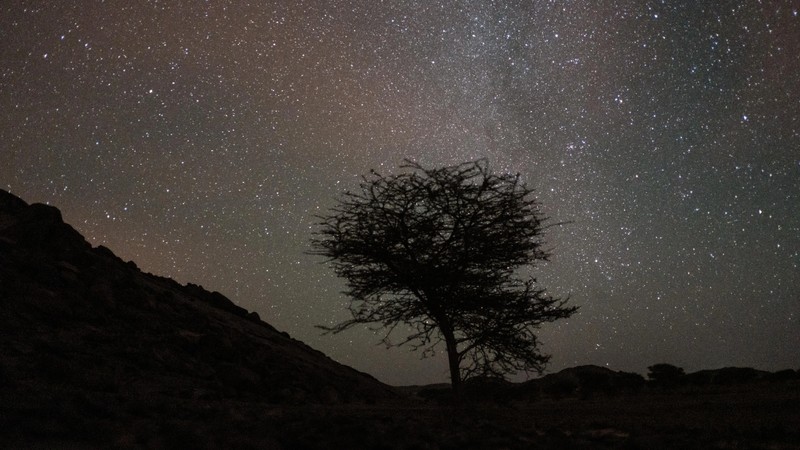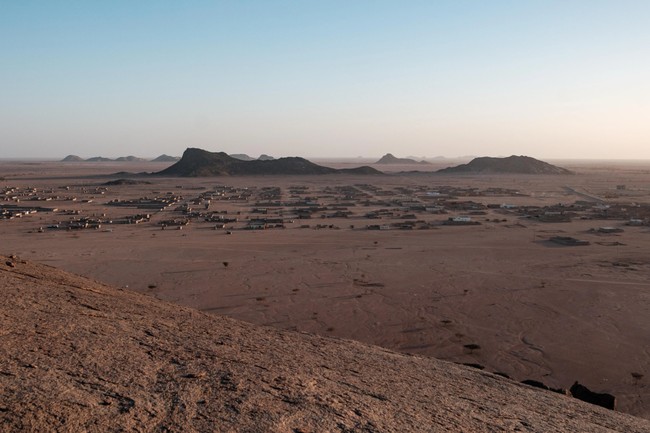
It’s possible you've spotted a meteorite without realizing it.
Scientists reckon that nearly 100,000 pounds of meteorite material plunges into Earth’s atmosphere daily. Most of this disintegrates as it races through the sky, producing streaks of light we call shooting stars.
Among the limited number of space rocks that reach our planet, the majority land in the sea. Those that do make it to dry land often go undetected, mixing in with ordinary stones.

However, in the Mauritanian desert, herders have acquired knowledge about identifying specific signs: stones featuring an unusually dark exterior referred to as the fusion crust. Although meteorites descend at equal rates globally, experts explain that these celestial objects can be more readily observed here, standing out vividly against the vast sandy backdrop.
Discovering uncommon stones has turned into a favored hobby - and a lucrative venture.
Travelling from Mauritania’s main city to this isolated Saharan settlement requires at least 18 hours of driving, with the final nine hours navigating unpaved sand paths. The majority of locals lead a nomadic lifestyle as livestock herders, migrating across the desert for several months each year alongside their animals. Internet access remains scarce for most inhabitants.

In 2011, nomadic people in nearby Morocco spotted a fireball illuminating their night sky. Subsequently, scientists verified that a substantial Martian meteorite had reached Earth; this was dubbed the Tissint meteorite. Experts think these fragments might provide clues about the presence of water on Mars. The pieces of the recovered meteorite were then distributed amongst various museums, private collectors, and scientific organizations for further study.
The finding ignited widespread enthusiasm throughout the area. News reached some of the remotest regions of Mauritania as well. The hunt was officially underway.
Herder Mohamed Bagouma estimates that around ten years back, he began searching for meteorites.
“It seemed odd to me,” stated Bagouma, who now places binoculars and notable stones he encounters on his car dashboard. “Initially, we believed these rocks held no value.”
While Bagouma and his boy journey across the sands with their dromedaries, they constantly scan the earth beneath them. Once only, recounted Bagouma, did he come upon a rock worth something, yet hope flickers within him as he remembers how another nearby shepherd stumbled upon an invaluable meteorite, enabling him to relocate his kin to urban life.
Bagouma presents the stones he has gathered to Lamine Henoun, the community's specialist.
A 50-year-old part-time security guard who studied literature in college and speaks multiple languages, Henoun has developed an encyclopedic knowledge of meteorites. The most common, he said, are chondrites, which come from the asteroid belt. The rarest - and most precious - are from Mars and the moon.
"This is really excellent," Henoun remarked, examining one of numerous stones Bagouma had shown him during an evening near his family’s tents recently.
Henoun retrieved a magnifying lens and a magnet from a tiny pouch. Since many meteorites have iron-nickle, which is a magnetic blend not typically seen in Earth’s stones, he positioned the magnet against what seemed like the most likely candidate among the rocks. However, when nothing stuck, he let out a disappointed sigh.
“The majority of the search relies on chance,” he stated.
Every day, the herders supply him with stones; however, only about one or two each month hold value. During these instances, he uses Starlink at the local customs office to get online and shares images on Facebook and TikTok, aiming to attract the notice of rock collectors.
The highest amount he ever earned from a single sale, which happened to be a rare kind of chondrite meteorite, was $55 – roughly equivalent to his monthly salary.
"The hidden aspect of meteorites, which isn't a positive one, is that the disadvantaged individuals around here aren't receiving any benefits," he stated.
Ahmedou Cheikh Abba stands out as an exception. This 36-year-old imam admitted that he hadn’t spent much time contemplating meteorites until one particular day in 2023, when he was part of a group excavating for gold close to the Algerian frontier.
While taking a smoking pause, "I noticed a rock that was darker compared to the rest," he mentioned. "Inside this stone, various hues were present. That made me think it might be indicative of a meteorite."
Abba uploaded the images to Facebook, and the comments started flooding in. He ended up selling it for $2,500 to a purchaser from Morocco, who believed it might be a moon rock fragment.
Following the assessment, the fellow delivered an disheartening report: It turned out to be nothing more than a regular stone. However, by this point, Abba had already distributed the funds among his broader kin and treated his kids to a holiday.
“He remarked with a shrug, ‘Everybody understands that risk comes with the territory.’”
The meteorite industry in Mauritania has absolutely no regulation whatsoever.
In a recent day in Nouakchott, the city’s center, several middle-aged gentlemen – who proudly identified themselves as meteorite traders – gathered beside the roadway, engaged in conversation beneath a makeshift shelter constructed from rugs and coverlets. Upon spotting incoming reporters, these individuals swiftly produced a collection of stones for display.
Hama Sidi Othaman grinned as he displayed his collection. He mentioned that he had been searching for meteorites since 2011.
He pointed out that one of the rocks in front of him was up for sale at a price tag of $64,000. He maintained that this was quite a bargain.
This," declared Sidi Othaman with pride, "must surely come from the moon.
Ely Cheikh Mohamed Navee serves as the president of Mauritania’s astronomy association and, he claims, is the sole Mauritanian holding a doctoral degree in planetary science.
Navee mentioned that six possible meteorite craters have been spotted within the nation, out of which only two have been verified by researchers and catalogued in the Earth Impact Database based in Canada.
Robert Ward, a meteorite collector based in Arizona, is part of an increasing group of amateur scientists fueling the market for extraterrestrial stones. According to him, some of his finest specimens have originated from North African countries like Mauritania.
He believes that there might be comparable treasures scattered throughout the American Southwest, but "everybody around here seems glued to their TV screens," he remarked. "Over there, folks spend each day searching for them."
Although Mauritania lacks a museum to showcase its meteorites and does not have an organized market for them, Navee acknowledged that his country boasts one significant benefit: "Nomads are the finest collectors globally," he stated.
He mentioned that the meteorites discovered here can provide us with significant insights into the cosmos - as well as our position within it.
The future," Navee stated, is "what comes from outer space.
The Washington Post